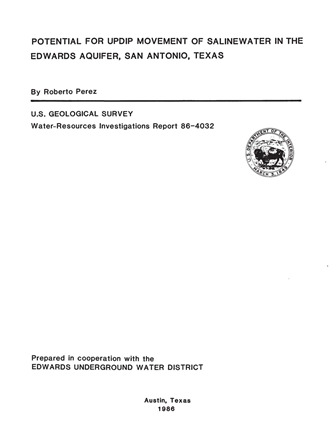Potential for Updip Movement of Salinewater in the Edwards Aquifer, San Antonio, Texas

| Author | Perez R |
| Year | 1986 |
| Description | Modeling the shift of the freshwater-saline water interface under various conditions over a 10-year period |
| Report Number | USGS WRIR 86-4032 |
| Publisher | US Geological Survey |
| Location | Edwards Aquifer, Balcones Fault Zone, San Antonio Segment |
| Cover | View Download |
| File | View Download |
| Summary |
|
The salinity front, locally known as the “bad-water” line, in the Edwards aquifer separates the freshwater from the salinewater and occurs where the aquifer is confined. The concentration of dissolved solids of the salinewater at the salinity front is 1,000 milligrams per liter. The concentration of dissolved solids in water within the freshwater zone of the aquifer usually ranges from 250 to 350 milligrams per liter. A digital model was used to investigate the potential movement of the salinity front by simulating the transport of salinewater into the freshwater zone as a result of pumping from the freshwater zone. The model simulations indicate that a large range in the quantity of solute transported from the salinewater zone into the freshwater zone is possible. This uncertainty is caused by the range of estimates of transmissivity, the magnitude of water-level decline, and porosity. Simulated transmissivity values for the Edwards aquifer within the salinewater zone ranged from 134 to 3,340 feet squared per day and resulted in potential lateral shifts of the salinity front from 16 to 425 feet updip into the freshwater zone at the end of a 10-year simulation. A simulated decline in water levels from an altitude of 660 to 582 feet above sea level resulted in a potential lateral shift in the salinity front of 133 feet updip into the freshwater zone at the end of the 10-year simulation. Simulated porosity values from l to 20 percent resulted in lateral shifts of the salinity front from 42 to 854 feet updip into the freshwater zone at the end of the 10-year simulation. An evaluation of the results of the model simulations indicates that contamination created by the movement of salinewater into the freshwater zone of the Edwards aquifer will be limited to an area within 0.2 mile of the present salinity front under the tested conditions. |
Search for Documents
Advance Search
Explore EAA's Scientific Reports
- All Reports
- Springs, Groundwater Discharge
- Archaeology
- RZ Protection
- Aquifer Levels
- Remote Sensing
- Precipitation
- Overview Studies
- Modeling
- Hydrology and Hydrogeology
- History
- Groundwater Recharge, Recharge Zone
- Groundwater Movement
- Geomorphology and Caves
- Weather Modification
- Geology
- Water Use and Conservation
- Geochemistry
- Water Resources Planning and Management
- Floods and Drought
- Water Quality
- Climatology
- Surface Water / Groundwater Relationship
- Biology
